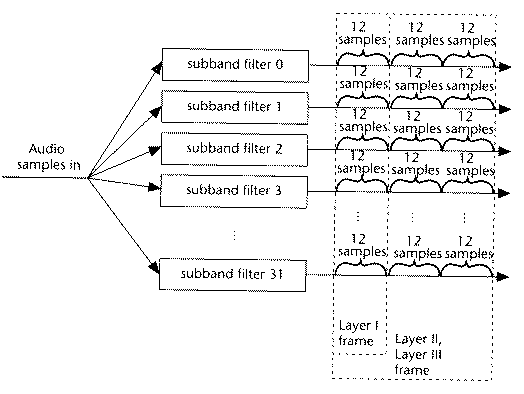Simple Audio Compression Methods
Psychoacoustics
MPEG Audio Compression
 Reference: Chapter 6 of Steinmetz and Nahrstedt
Reference: Chapter 6 of Steinmetz and Nahrstedt
 Reference: Davis Pan, "A Tutorial on MPEG/Audio Compression",
IEEE Multimedia, Vol. 2, No. 2, pp. 60-74, 1995.
Reference: Davis Pan, "A Tutorial on MPEG/Audio Compression",
IEEE Multimedia, Vol. 2, No. 2, pp. 60-74, 1995.

- Traditional lossless compression methods (Huffman, LZW, etc.)
usually don't work well on audio compression (the same reason as
in image compression).
The following are some of the Lossy methods:
Human hearing and voice
- Frequency range is about 20 Hz to 20 kHz,
most sensitive at 2 to 4 KHz.
- Dynamic range (quietest to loudest) is about 96 dB
- Normal voice range is about 500 Hz to 2 kHz
- Low frequencies are vowels and bass
- High frequencies are consonants
Critical Bands
- Human auditory system has a limited, frequency-dependent resolution.
The perceptually uniform measure of frequency can be expressed in terms
of the width of the Critical Bands.
It is less than 100 Hz at the lowest audible frequencies,
and more than 4 kHz at the high end. Altogether, the audio frequency
range can be partitioned into 25 critical bands.
- A new unit for frequency bark (after Barkhausen)
is introduced:
1 Bark = width of one critical band
For frequency < 500 Hz, it converts to
freq / 100 Bark,
For frequency > 500 Hz, it is  Bark.
Bark.
Sensitivity of human hearing in relation to frequency
- Experiment: Put a person in a quiet room. Raise level of 1 kHz tone
until just barely audible. Vary the frequency and plot
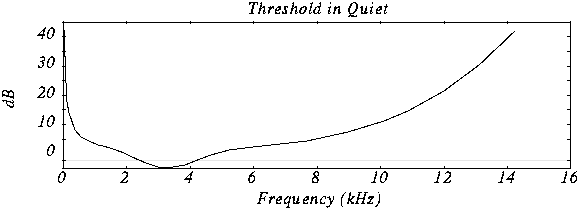
Frequency Masking
Question: Do receptors interfere with each other?
- Experiment: Play 1 kHz tone (masking tone) at fixed
level (60 dB). Play test tone at a different
level (e.g., 1.1 kHz), and raise level until just distinguishable.
- Vary the frequency of the test tone and plot the threshold
when it becomes audible:
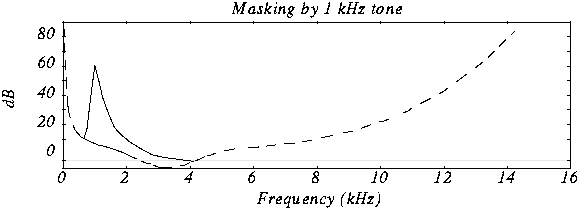
- Repeat for various frequencies of masking tones
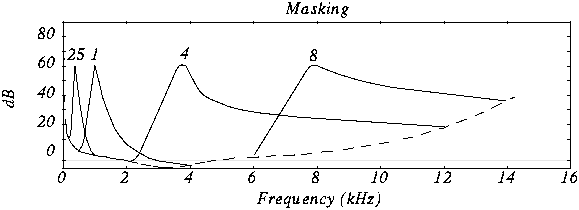
- Frequency Masking on critical band scale:
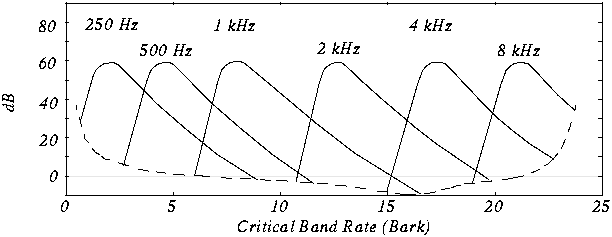
Temporal masking
- If we hear a loud sound, then it stops, it takes a little while
until we can hear a soft tone nearby.
- Experiment: Play 1 kHz masking tone at 60 dB, plus
a test tone at 1.1 kHz at 40 dB.
Test tone can't be heard (it's masked).
Stop masking tone, then stop test tone after a short delay.
Adjust delay time to the shortest time when test tone can be heard (e.g., 5 ms).
Repeat with different level of the test tone and plot:

- Total effect of both frequency and temporal maskings:
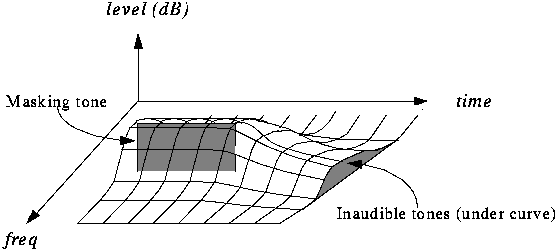
Some facts
- MPEG-1: 1.5 Mbits/sec for audio and video
About 1.2 Mbits/sec for video, 0.3 Mbits/sec for audio
(Uncompressed CD audio is 44,100 samples/sec * 16 bits/sample * 2 channels > 1.4 Mbits/sec)
- Compression factor ranging from 2.7 to 24.
- With Compression rate 6:1 (16 bits stereo sampled at 48 KHz is reduced
to 256 kbits/sec) and optimal listening conditions, expert listeners could
not distinguish between coded and original audio clips.
- MPEG audio supports sampling frequencies of 32, 44.1 and 48 KHz.
- Supports one or two audio channels in one of the four modes:
- Monophonic -- single audio channel
- Dual-monophonic -- two independent channels, e.g., English and French
- Stereo -- for stereo channels that share bits, but not using
Joint-stereo coding
- Joint-stereo -- takes advantage of the correlations between stereo
channels
Steps in algorithm:
- Use convolution filters to divide the audio signal (e.g., 48 kHz
sound) into 32 frequency subbands --> subband filtering.
- Determine amount of masking for each band caused by nearby band
using the psychoacoustic model shown above.
- If the power in a band is below the masking threshold, don't encode it.
- Otherwise, determine number of bits needed to represent the
coefficient such that noise introduced by quantization is below the
masking effect (Recall that one fewer bit of quantization introduces
about 6 dB of noise).
-
Format bitstream
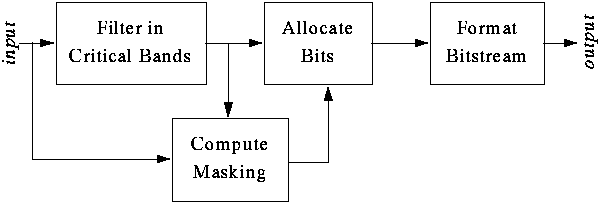
Example:
- After analysis, the first levels of 16 of the 32 bands are these:
----------------------------------------------------------------------
Band 1 2 3 4 5 6 7 8 9 10 11 12 13 14 15 16
Level (db) 0 8 12 10 6 2 10 60 35 20 15 2 3 5 3 1
----------------------------------------------------------------------
- If the level of the 8th band is 60dB,
it gives a masking of 12 dB in the 7th band, 15dB in the 9th.
Level in 7th band is 10 dB ( < 12 dB ), so ignore it.
Level in 9th band is 35 dB ( > 15 dB ), so send it.
[ Only the amount above the masking level needs to be sent, so
instead of using 6 bits to encode it, we can use 4 bits -- a saving
of 2 bits (= 12 dB). ]
MPEG Layers
Effectiveness of MPEG audio
|
Layer |
Target
Bit-rate |
Ratio |
Quality at
64 kb/s |
Quality at
128 kb/s |
Theoretical
Min. Delay |
|
Layer 1 |
192 kb/s |
4:1 |
--- |
--- |
19 ms |
|
Layer 2 |
128 kb/s |
6:1 |
2.1 to 2.6 |
4+ |
35 ms |
|
Layer 3 |
64 kb/s |
12:1 |
3.6 to 3.8 |
4+ |
59 ms |
- Quality factor: 5 - perfect, 4 - just noticeable,
3 - slightly annoying, 2 - annoying, 1 - very annoying
- Real delay is about 3 times of the theoretical delay
Further Exploration 
MPEG Resources on the Web.
Top |
Chap 4 |
CMPT 365 Home Page |
CS
![]() Reference: Chapter 6 of Steinmetz and Nahrstedt
Reference: Chapter 6 of Steinmetz and Nahrstedt
![]() Reference: Davis Pan, "A Tutorial on MPEG/Audio Compression",
IEEE Multimedia, Vol. 2, No. 2, pp. 60-74, 1995.
Reference: Davis Pan, "A Tutorial on MPEG/Audio Compression",
IEEE Multimedia, Vol. 2, No. 2, pp. 60-74, 1995.
 Bark.
Bark.







